“Those who believe are never alone … faith tends to spread, as it invites others to share in its joy,” Pope Francis writes in Lumen Fidei, his first encyclical. “Those who receive faith discover that their horizons expand as new and enriching relationships come to life.”
Much of the work carried out by Sisters of the Precious Blood is built on forming new and enriching relationships. Ecology, interfaith dialogue, parish ministry or professional counseling — any setting can provide an opportunity for the Holy Spirit to guide us in building relationships with others.
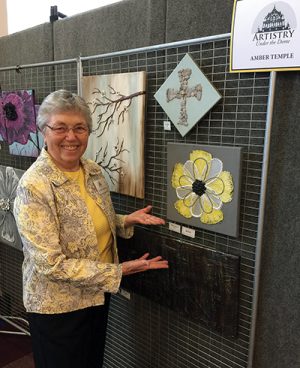
Sister Martha Bertke: Building community through art
Right, Sister Martha at Artistry Under the Dome; contributed photo.
Abstract paintings in bright colors. Beaded necklaces and earrings. Striking photographs of scenes from nature. Pottery, wooden bowls, copper mugs, intricate beadwork and hand-blown glass. The artwork varies in form and style, but each piece represents the singular vision of the artist who created it. At Artistry Under the Dome, an annual juried art exhibit held at St. Charles Senior Living Community, the work also represents a community of artists who all reside in or hail from Mercer and Auglaize counties.
Thirty-four artists participated in this year’s exhibit, held April 6-8. While new artists join every year, many have been part of the show since it began in 2013. “They say it’s like family; once a year, they’re back together again,” said Sister Martha Bertke, who founded the event and continues to serve on the organizing committee.
For some, Sister Martha said, the work takes on deep spiritual significance. “As I work with some of the artists, they talk about experiencing God as they do that artwork. There’s a lot of beauty in our world. To be able to take that and put it on a canvas or to create something out of clay — there’s a real spiritual dimension to that.”
Sister Martha first began visiting art museums in the 1980s while serving in education and pastoral ministry; over the years, she became more and more interested in art and using art events to help create a sense of community in the northern part of the Cincinnati archdiocese.
The Lake Area Arts Group provides another avenue for that effort. Meetings are held every other month; workshops feature “Meet the Artist” gatherings on Friday evenings, with an instructional seminar the next day. For all the group’s events, the aim is to encourage camaraderie, promote art appreciation, and provide inspiration and opportunities for artists to continue to learn and develop. Selected artwork by group members is on display at libraries throughout Mercer County, as well as the city building in Celina.
Story by Mary Knapke
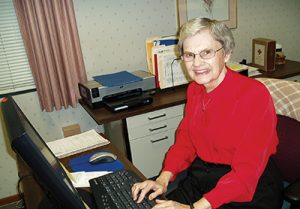 Sister Jeanette Buehler: What does it mean to build community?
Sister Jeanette Buehler: What does it mean to build community?
Right, Sister Jeanette; contributed photo. On the cover, Organizers of the Women’s Interfaith Discussion – (clockwise from left) Sister Jeanette, Bushra Shahid and Phyllis Pavlofsky Allen; Michelle Bodine photo.
Among her many social justice activities, Sister Jeanette Buehler coordinates prayer vigils at sites where homicides have occurred in the Dayton area. She is also part of the planning committee for the Women’s Interfaith Discussion group, in which “women of different religious groups come together in an informal, interactive session to break down barriers, learn about and understand each other, foster good relations and strengthen community ties.” She shared her thoughts about building community.
As I began to think about building community, I thought, “I don’t know if we build community at all when we do these projects.” That, in turn, caused me to rethink what my concept of community is. I got to thinking about that whole sense of “comm-union” — of being with others in some form of unity. What does it mean to build community? It’s a binding of heart and soul in terms of something that is meaningful and important to you. I’ve never identified some of our events and activities as a community in itself, but what is happening is that kind of thing.
We come together for homicide vigils, and one of the prayers we use says that we will have the courage to stand week after week if necessary to witness to nonviolence. Yes, that is community.
In the Women’s Interfaith Discussion, I am on the planning committee with Bushra Shahid from Dayton’s Fazl-i-Umar Mosque and Phyllis Allen from Beth Jacob Congregation. The sharing that the three of us do in the planning is always so enlightening. I learn so much just by being with the other two women. We’ve been averaging almost 80 women at our events now the last couple of months. Many of them keep coming back, and other women come for the first time, and that is a community — a desire to know and understand one another. To respect our differences, but also to discover the commonalities. It’s that desire to build a better world that really brings us together.
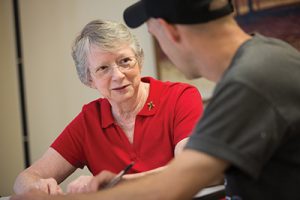 Sister Joanne Belloli: The key is compassion
Sister Joanne Belloli: The key is compassion
Right, Sister Joanne with a client in Howell, Michigan; contributed photo.
Professionally, I facilitate three groups in a week. The initial commonality is that the members of each group have a substance abuse issue that led them into treatment. Recently I asked one of the groups to identify words that describe community to them. Those identified were:
- forgiveness
- safety
- communication
- working together
- unity
- sharing
- camaraderie
- church/religion
- trust
- loyalty
- friendship
Overlaying all these words is bonding. I began to ask myself how I facilitate community among various groups. The initial words that came to me were:
- respect
- assisting
- supporting
- encouraging
- listening
- challenging
This group was time-specific. As members become comfortable within themselves and begin to trust the treatment process, they begin and continue to interact with one another, supporting one another in their recovery process and with the issues that affect their lives on a daily basis — unemployment, employment, physical health concerns, probation/parole requirements, family relationships. They share their personal life transitions, hopes, dreams, maintaining sober living. My efforts are to let their process of life evolve. My role becomes providing topics for discussion.
In working with a group of professional men who are in a three-, five- or seven-year monitoring program given their history of substance use problems, it is, and has been, a delight to observe the community building that occurs over a longer period of time.
Precious Blood Spirituality is evidenced as healing occurs in the lives of the men and women who come to respect themselves, forgive themselves and build a sense of community — evidenced in the interactions with one another and in their explanation of improved relationships and self-respect. Compassion is a defining role in my interactions. I am grateful to observe the healing, forgiveness and reconciliation that occurs.
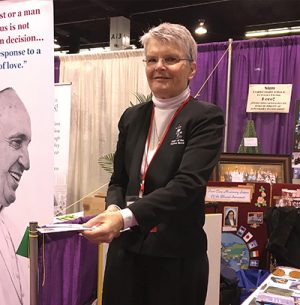 Sister Terry Maher: Community — the Art of Possibilities
Sister Terry Maher: Community — the Art of Possibilities
Right, Sister Terry at the Los Angeles Religious Education Congress in 2018; contributed photo.
There once were two monks who had lived together many years. One day, the younger of the two realized that he and the older monk had never had an argument. So, one morning at breakfast, the younger said to the older, “In all the years we have lived together, we have never had an argument. I think we ought to have one.” The older monk replied, “Why?” To which the younger replied, “I just find it odd that we have never had an argument. I think we ought to try.” The older one replied, “OK, let us try.” The younger monk then grabbed a piece of bread, saying, “This piece of bread is mine.” The older monk replied, “Okay.”
Those of us who have lived in community may have chuckled at the above scenario. However, in reality, was the older monk the wiser one by keeping peace in the house? Was the younger monk perhaps exploring the possibility of deepening a relationship with the older monk so their community life together could be more meaningful? Was the older monk not able to respond to the younger monk because of age difference, perhaps fearful to reveal some part of himself to the younger monk? Perhaps the younger monk came from a different culture and arguing was a way of learning about another.
How we live community reflects well who we are. Are we open to new ideas, new members, new cultures, new hopes and new dreams? In community we may search for the ideal and then the reality of rubbing elbows can awaken us to who we can become if we can engage another with dignity, respect and hope — keeping God at the center of all we are about.
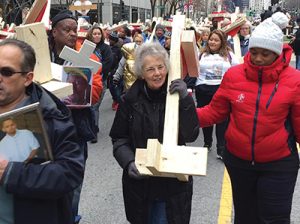 Sister Donna Liette: Practicing radical hospitality
Sister Donna Liette: Practicing radical hospitality
Sister Donna in Chicago during the march to remember the 762 lives lost to gun violence in 2016; Father Denny Kinderman photo.
Community is a safe place where all are welcome and respected despite differences. In our culture of individualism, community is unfathomable but possible. At Precious Blood Ministry of Reconciliation (PBMR) we strive to restore a community affected by violence, generational poverty and racial division. As a Restorative Justice Hub, we offer a safe place where peoples of diverse backgrounds can come together in circle and share their brokenness and their differences, and be heard and respected.
Monthly, women gather who have lost their children/loved ones to gun violence and/or incarceration. They first gather at the table for food and laughter then into our sacred space to sit in circle and share their struggles, their fears and their reflections on life “in the hood” — suddenly they do not feel the isolation, the shame that they had experienced during the week. They feel a connection, a healing, a transformation, a safe community. Here as they say, “we are not judged as unworthy women.” They struggle together, not against one another — victim and offender, black, white and Hispanic, comforting and embracing one another. All human emotions are welcome in the circle and are held as sacred.
To us, this is Precious Blood Spirituality where radical hospitality is offered to each person who enters our doors. Each one is invited into our sacred space and honored as redeemed and bought at a great price. Anyone who feels far off (the returning citizen from incarceration, the alcoholic mother, the youth with baggy pants and dreadlocks, the bisexual…) is brought close through the practice and living of our Precious Blood Spirituality.
One of our recent projects is the creating of peace poles within the community because as people come together designing, building and painting the poles, they connect, they lay aside differences and share stories while producing a symbol of hope for a nonviolent community!
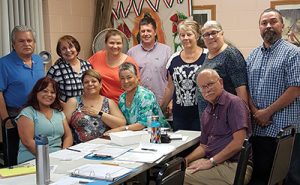
Sister Mary Garascia: A sense of mission is the starting point
Sister Mary (second from left, standing) with the Social Concerns Committee; contributed photo.
Ekklesia and koinonia are Greek biblical words that are at the heart of what community means. Ekklesia, from which we derive the word “church,” in Greek civil society meant a group gathered together for a purpose. In the New Testament, Paul began using ekklesia to designate that Spirit-animated group of witnesses to the good news and co-workers in the Kingdom. Koinonia or “community” is the bondedness or unity that comes from participating together in this mission and from experiencing that unity in a sacred meal (Acts 2:42-47). For me, these words sum up what I experienced as I built community among the folks whom I have served.
It has seemed to me that the sense of mission is the starting point; human persons are purposeful! From a sense of mission, unity of persons develops. In Dayton in the ’90s, men and women religious at the grassroots level were passionate about social justice, but there was no real focus or mission. I and a Sister of Charity convened a representative group. A specific need in a specific place was identified, a strong sense of a mission developed, and about eight congregations contributed annual funding for the Founders Family Center.
In the ’80s in my Denver parish, a group of families from the family faith formation program couldn’t get their schedules to match ours. So I suggested they meet in one another’s homes. Each week several parents taught the children while the other adults did their own faith formation, using a small faith community model. Such strong bonds developed from their mission of teaching their own children that those parents continued meeting long after they became empty nesters.
Sometimes there is a need first to build a sense of unity and trust. In Redlands, California, I started by listening to the hurts in a merged parish, which was in a state of rage and grief. But I also gave a clear call to reconciliation and specified behaviors and practices that made reconciliation more likely. For example, staff members agreed to settle any differences between them by constructive conversation within 48 hours.
When Hoover Place senior community in Dayton opened in the late ’90s, I found many divisions among the residents. It mattered what part of the South you hailed from, what sorority you belonged to, which African-American church you attended. That February, Black History Month, I asked the residents if they would like to display things they owned that reflected their African heritage. I set up two display tables, and then I had to set up more tables, and even more! That action, that little mission they did together, revealed to the residents their common unity, and after that the house began to hum.
At the Michigan parish I led, people had drifted into pro forma parish membership. The place was dead. The simple solution was to begin a social committee that invited people to play together. Euchre nights, garden tours, rummage sales, picnics and pig roasts, and “Guess Who’s Coming to Dinner” changed the spirit of the parish by helping people cross lines and get to know one another. By the time I left, the parish had adopted a mission outreach to a youth shelter and had helped establish the village farmers market.
So there is no one starting point to building community, but there is always something physical about community. People have to spend time together, touch each other, hear each other’s voices, struggle together, laugh together and eat together. Community is not mental! Ekklesia and koinonia, mission and the bonded love unity that flows from mission, entail opening our souls to one another. When the social concerns committee I chair meets, we always begin with faith sharing; then we get down to business. And it’s a great night when one of the members brings warm banana bread! When you think about it, Eucharist is about all this — being gathered for a mission, being united with others and the Lord in doing it, and eating! It’s really pretty simple, isn’t it?
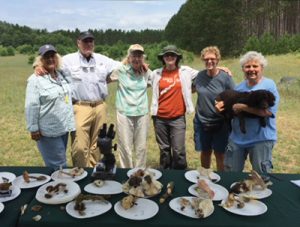 Sister Marie Kopin: Building community through eco-spirituality
Sister Marie Kopin: Building community through eco-spirituality
Sister Marie (far right) with members of the Michigan Mushroom Hunters Club; contributed photo.
I see community as a working and living body of life and connectedness. I have been given a gift of building an “eco-spirituality” community here in Michigan. It all started with my family background from southern Poland, a land not too far from where Maria Anna Brunner lived. My great-grandmother hunted mushrooms in the Polish Alps in what was termed “Austria” before World War I. She taught my dad in Genesee County, Michigan, and then he taught me as a little girl, and later much more after I moved back to Michigan to teach at Central Michigan University. I am now active with many individuals and clubs at the local, state and national levels.
This has been “unplanned,” more like taking advantage of opportunities when they arise — certainly the work of the Holy Spirit. After being networked with the North American Mycological Association (NAMA) through my dad, I joined the NAMA affiliate club in Michigan. After my retirement from CMU, I started leading forays and educational activities, which eventually meant networking with many people.
I now work with our Isabella County Parks, Chippewa Watershed Conservancy, Michigan Nature Association, Audubon local club, Commission on Aging, and Mount Pleasant city parks. Sometimes I add local garden clubs, state parks and other groups such as our tribal-based Gathering Society and our Great Lakes Stewardship conference. I’ve also done intercommunity work with the Sisters of Mary Reparatrix at their Full Circle EcoHouse of Prayer in Port Huron, and with the Grand Rapids Dominican Sisters “brain training” program. I’ve taught about curriculum for fungi at an international teachers’ conference in Windsor, Ontario, and presented basics at the Franciscan-based Sisters of Earth (SOE) 2016 conference in California. I work to lead others to network and work together, forming communities with these groups by assuming leadership roles in NAMA, our Michigan Mushroom Hunters Club and Delta Kappa Gamma, an international teachers’ association.
It seems like the Holy Spirit has kept offering me these opportunities. How can I turn them down? They build all kinds of new relationships which keep spreading, just as the mycelium of fungi interact and spread and nourish all living things — just as is done with the Precious Blood of Jesus.
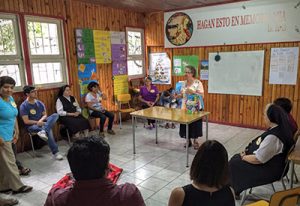 Sister Maria Luisa Miller: Building community through Precious Blood Spirituality in Chile
Sister Maria Luisa Miller: Building community through Precious Blood Spirituality in Chile
Sisters Rita (far left, standing) and Maria Luisa (at table, standing) with facilitators for circles in Circle Training. They are laity and members of the three congregations. Contributed photo
Community implies sharing, loving, taking others into one’s heart and daily living, overlooking the difficulties that are part of life, and searching to enrich the lives of others through communion, dialogue, fidelity and forgiveness.
Our experiences as Sisters in Chile have led us to share in many lives in our pastoral ministries.
Many communities have been formed, and we would like to share with you some of these beautiful people who have entered into our lives, but first into the life of JESUS. During our 60-plus years in Chile we have “built communities” in many parishes and pastoral areas.
From the city to country areas, large and small parishes, the archdiocesan offices, the Conference of Religious, various schools (which includes the “first love” of many Sisters upon arriving in Chile) and St. Gaspar College of the Missionaries of the Precious Blood. We are told that the Sisters made a marked impression upon the parents and students in St. Gaspar College. Even until today, we continue with contacts with the school through the Family of the Blood of Christ of Chile.
We participate with the three congregations of the Precious Blood in Chile in deepening our Precious Blood Spirituality with the laity. Every two years we have a Precious Blood seminar to share formation in Precious Blood Spirituality, the last being in 2017, sharing the community experiences of many of the groups formed in the spirituality in Chile. Did you know that Precious Blood Spirituality began in Rome in the 1800s, with laity?
Our next seminar will be in January 2019, “The Spirituality of the Blood of Christ in Defending Life and Creation.” This seminar will be based on Pope Francis’ encyclical Laudato Si.
With the Spirit of God guiding us, we have participated for years in forming communities who share with each other their lives and challenges, pains and joys. Among these past two years of pastoral activities, Sister Edna Hess is coordinating the community activities with the many Haitian people who have come into Chile and some in our parish. Sister Maria Luisa Miller accompanies the area of catechists and preparation for the sacraments.
Sister Noemi Flores coordinates the Precious Blood groups in the parish and communion ministers. Sister Rita Manríquez-Silva began the coordinating team for fraternal help to the needy, among whom are many of the Haitian people. She also accompanies the youth group in the parish.
Today we are in Our Lady of the Precious Blood Parish with the Missionaries of the Precious Blood. We endeavor to share quite a bit with the Fathers in the pastoral areas and accompanying the Precious Blood community in the parish. May this Saving Precious Blood enrich and bring new life to many people.




